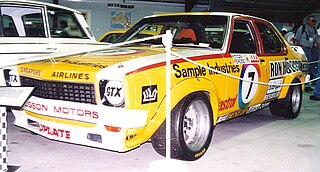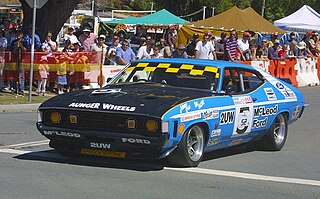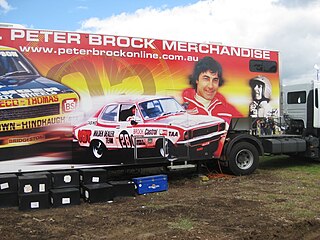Related Research Articles

The Holden Torana is a mid-sized car that was manufactured by Holden from 1967 to 1980. The name comes from an Aboriginal word meaning "to fly". The original HB series Torana was released in 1967 and was a four-cylinder compact vehicle closely based on the British Vauxhall Viva HB series of 1966 - 1970.
The 1974 RE-PO 500K was an endurance race for Group C Touring Cars. It was held at the Phillip Island Circuit in Victoria, Australia on 24 November 1974 over 106 laps, a race distance of 501 kilometres (311 mi). The race, which was the fifth round of the 1974 Australian Manufacturers' Championship, was the fourth annual "Phillip Island 500K".
The 1960 Armstrong 500 was an endurance motor race for Australian made or assembled standard production sedans. The event was held at the Phillip Island Grand Prix Circuit in Victoria, Australia on 20 November 1960 over 167 laps of the 3.0 mile circuit, a total distance of 501 miles.
Henry Leslie Firth was an Australian racing driver and team manager. Firth was a leading race and rally driver during the 1950s and 1960s and continued as an influential team manager with first the Ford works team and then the famed Holden Dealer Team (HDT) well into the 1970s. Firth’s nickname was "the fox", implying his use of cunning ploys as a team manager.
The 1979 Hardie-Ferodo 1000 was the 20th running of the Bathurst 1000 touring car race. It was held on 30 September 1979, at the Mount Panorama Circuit just outside Bathurst. The race was open to cars eligible to the locally developed CAMS Group C touring car regulations with four engine capacity based classes.

The 1978 Hardie-Ferodo 1000 was the 19th running of the Bathurst 1000 touring car race. It was held on 1 October 1978, at the Mount Panorama Circuit just outside Bathurst. The race was open to cars eligible to the locally developed CAMS Group C touring car regulations with three engine capacity based classes.

The 1977 Hardie-Ferodo 1000 was a motor race for Group C Touring Cars, held on 2 October 1977 at the Mount Panorama Circuit just outside Bathurst in New South Wales, Australia. It was the 18th in a sequence of "Bathurst 1000" events commencing with the 1960 Armstrong 500.

The 1976 Hardie-Ferodo 1000 was the 17th running of the Bathurst 1000 touring car race. It was held on 3 October 1976 at the Mount Panorama Circuit just outside Bathurst in New South Wales, Australia. The race was open to cars complying with CAMS Group C Touring Car regulations.

The 1974 Hardie-Ferodo 1000 was an endurance race for Group C Touring Cars, held at the Mount Panorama Circuit near Bathurst in New South Wales, Australia on 6 October 1974. The race was Round 3 of the 1974 Australian Manufacturers' Championship and was the 15th in a sequence of annual “Bathurst 1000” races commencing with the 1960 Armstrong 500.
The 1979 Hang Ten 400 was an endurance motor race held at the Sandown Park circuit in Victoria, Australia on 9 September 1979. It was staged over 129 laps of the 3.11 km circuit, a total of 401 km. The race was Round 1 of the 1979 Australian Championship of Makes and as such it was open to Group C Touring Cars. It was the fourteenth in a sequence of annual Sandown long distance races. The race was won by Peter Brock.
The 1973 Hardie-Ferodo 1000 was the 14th running of the Bathurst 1000 touring car race. This was the first race to be held under the new metricised distance of 1000 kilometres, rather than the 500 miles previously contested. It was held on 30 September 1973 at the Mount Panorama Circuit just outside Bathurst. The race was open to cars eligible to the locally developed CAMS Group C touring car regulations with four engine capacity based classes and it was the 3rd round of the 1973 Australian Manufacturers' Championship.

The 1972 Hardie-Ferodo 500 was an endurance motor race open to Group E Series Production Touring Cars. The race was held on 1 October 1972 at the Mount Panorama Circuit just outside Bathurst in New South Wales, Australia. Cars competed in four classes defined by Capacity Price Units, where the engine capacity, expressed in litres, was multiplied by the purchase price in Australian dollars to arrive at a CP value for each vehicle. It was the 13th running of the Bathurst 500 race and the last to be held over the original distance of 500 miles. It was also the last to allow drivers to compete for the full distance without a relief driver. The race was the third round of the 1972 Australian Manufacturers' Championship.
The 1961 Armstrong 500 was an endurance motor race for standard production sedans. The event was held at the Phillip Island circuit in Victoria, Australia on 19 November 1961 over 167 laps of the 3.0 mile circuit, a total of 501 miles (807 km). The race was organised by the Light Car Club of Australia and was sponsored by Armstrong York Engineering Pty Ltd.
The 1971 Hardie-Ferodo 500 was a motor race held on 3 October 1971 at the Mount Panorama Circuit just outside Bathurst in New South Wales, Australia. It was open to production vehicles competing in showroom condition, with the field divided into five classes based on the purchase price of the vehicle in Australian dollars. Although an outright winner was officially recognised, all other official awards were for class results only. The race was the 12th in a sequence of annual "Bathurst 500" production car races dating back to the 1960 Armstrong 500. The outright winner was Allan Moffat driving a Ford XY Falcon GT-HO Phase III.
The 1970 Hardie-Ferodo 500 was the 11th running of the Bathurst 500 touring car race. It was held on 4 October 1970 at the Mount Panorama Circuit just outside Bathurst. The race was open to standard production sedans competing in five classes based on the purchase price of the vehicle.
The 1973 Sandown 250 was an endurance race for Group C Touring Cars. It was staged at Sandown in Victoria, Australia on 9 September 1973 over 130 laps of the 3.1 km circuit, a total distance of 403 km (250 mi). The race was Round 2 of the 1973 Australian Manufacturers' Championship and was the eighth in a sequence of annual endurance races now known as the Sandown 500.
The Sun-7 Chesterfield Series was an Australian touring car racing series staged at Amaroo Park in Sydney, New South Wales from 1971 to 1981. The actual series name varied from year to year, according to the commercial sponsorship secured by the series promoters, the Australian Racing Drivers Club.
The 1982 Australian Touring Car Championship was a CAMS sanctioned Australian motor racing title open to Group C Touring Cars. It began on 18 February 1982 at Sandown Raceway and ended on 16 May at Oran Park Raceway after eight rounds. The title, which was the 23rd Australian Touring Car Championship, was won by defending champion Dick Johnson, driving a Ford XD Falcon.
The 1977 Australian Touring Car Championship was a CAMS sanctioned Australian motor racing championship open to Group C Touring Cars. It was the 18th running of the Australian Touring Car Championship. The championship began at Symmons Plains Raceway on 7 March and ended at the Phillip Island Grand Prix Circuit on 20 November after eleven rounds. 1977 was the second and final time that the series incorporated the longer distance races which made up the Australian Championship of Makes. These races included the Sandown 400 and the Phillip Island 500K, although notably not the Bathurst 1000.
The 1972 Australian Touring Car Championship was a CAMS sanctioned national motor racing title open to Improved Production Touring Cars and Group E Series Production Touring Cars. The championship, which was the 13th running of the Australian Touring Car Championship, began at Symmons Plains and ended at Oran Park after eight rounds.
References
- ↑ Conditions for Australian Titles, 1973 CAMS Manual of Motor Sport, page 95 – indicates that the 1973 Australian Manufacturers Championship was open to Group C Touring Cars
- 1 2 3 4 5 6 7 8 9 10 11 12 13 14 15 16 17 18 19 Phillip Island 500k, Australian Competition Yearbook, 1974 Edition, pages 139 to 143
- ↑ It has been assumed that all of the thirteen "XU-1" entries listed in the results published in Stewart Wilson's, The Official Racing History of Holden, 1988, page 337 were LJ series Torana GTR XU-1s
- 1 2 3 4 5 6 7 8 9 10 11 Phillip Island Double, Modern Motor, February 1974, page 98 to 101
- 1 2 3 4 5 6 7 8 9 10 11 General Firth’s Man.Champ.Coup, Australian Motor Manual, February 1974, pages 64 & 65
- 1 2 Image of No 22 Holden LJ Torana of Barry Nixon Smith at Phillip Island on 25 November, www.autopics.com.au Retrieved on 12 November 2013
- 1 2 Image of No 30 Holden LJ Torana of John Stoopman at Phillip Island on 25 November, www.autopics.com.au Retrieved on 12 November 2013
- 1 2 Image of No 49 Alfa Romeo of Ray Harrison at Phillip Island on 25 November, www.autopics.com.au Retrieved on 12 November 2013
- 1 2 Image of No 37 Holden LC Torana GTR of Roger Bonhomme at Phillip Island on 25 November, www.autopics.com.au Retrieved on 12 November 2013
- ↑ Image of No 54 Morris Cooper S of John Lord at Phillip Island on 25 November, www.autopics.com.au Retrieved on 12 November 2013
- ↑ Image of No 55 Fiat 128 Coupe of Lakis Manticas at Phillip Island on 25 November, www.autopics.com.au Retrieved on 12 November 2013
- 1 2 3 Image of No 62 Morris Cooper S of Geoff Newton at Phillip Island on 25 November, www.autopics.com.au Retrieved on 12 November 2013
- 1 2 3 Image of No 59 Mazda 1300 of Lynne De Luca at Phillip Island on 25 November, www.autopics.com.au Retrieved on 12 November 2013
- ↑ Image of No 45 Mazda RX-3 of Mel Mollison at Phillip Island on 25 November, www.autopics.com.au Retrieved on 12 November 2013
- ↑ Image of No 50 Mazda R100 Coupe of Raymond Harrison at Phillip Island on 25 November, www.autopics.com.au Retrieved on 12 November 2013
- 1 2 3 Image of the No 48 Mazda RX-3 of Geoff Perry at Phillip Island on 25 November, www.autopics.com.au Retrieved on 12 November 2013
- 1 2 3 Image of the No 38 Ford Escort Twin Cam of Geoff Wade at Phillip Island on 25 November, www.autopics.com.au Retrieved on 12 November 2013
- ↑ Image of No 40 Alfa Romeo of Christine Cole at Phillip Island on 25 November, www.autopics.com.au Retrieved on 12 November 2013
- ↑ Image of No 44 Ford Escort of Graeme Ritter at Phillip Island on 25 November, www.autopics.com.au Retrieved on 12 November 2013
- ↑ Image of No 43 Ford Escort of Bob Holden at Phillip Island on 25 November, www.autopics.com.au Retrieved on 12 November 2013
- ↑ Image of No 36 Datsun 240K of Tony Roberts at Phillip Island on 25 November, www.autopics.com.au Retrieved on 12 November 2013
- ↑ Image of No 15 Ford Falcon of Murray Carter at Phillip Island on 25 November, www.autopics.com.au Retrieved on 12 November 2013
- 1 2 3 4 Stewart Wilson & Max Stahl, The Australian Racing History of Ford, 1989, page 290
- 1 2 Image of No 12 Holden LJ Torana of Rod McRae at Phillip Island on 25 November, www.autopics.com.au Retrieved on 12 November 2013
- 1 2 Image of No 27 Holden LJ Torana of Stuart saker at Phillip Island on 25 November, www.autopics.com.au Retrieved on 12 November 2013
- ↑ Image of No 5 Ford Falcon of John Goss at Phillip Island on 25 November, www.autopics.com.au Retrieved on 12 November 2013